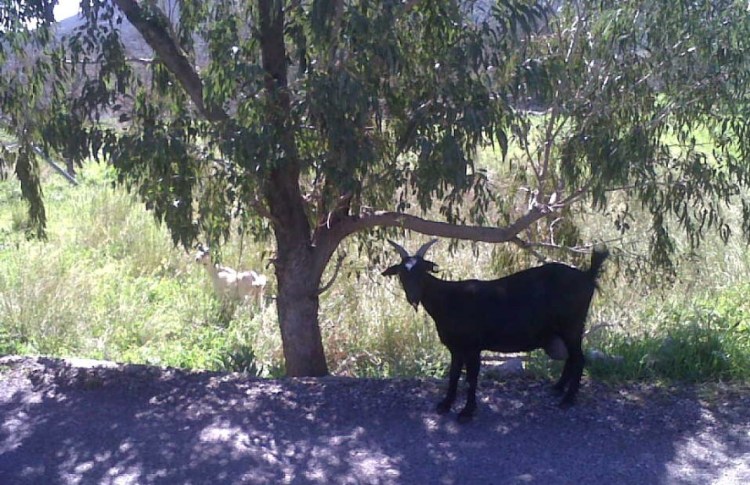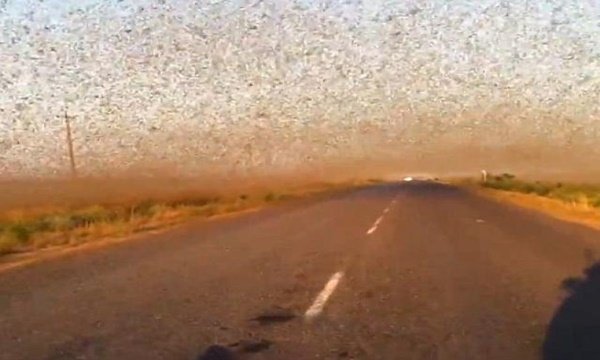David M. Boje
June 29, 2019
What is the relationship between storytelling and all kinds of systems, human ones, and nature’s? They are obviously entangled in what’s happening in the Anthropocene. It’s all about patterns, sociomaterial, socioeconomic, sociocultural, artificial systems in relation to what’s left of natural systems after all the global warming. The relationship between storytelling, human systems, and natural systems, is not going so well, as the Anthropocene takes a fatal turn. Everyone but Tump knows humanity is on the most dangerous path, one that many say is Sixth Extinction, because ‘there is no planet B’ (Boje, 2019). It’s about the little creatures, so often overlooked.

Tilos Island Goat
For example, I am finishing up three weeks of vacation on Tilos Island.Grace Ann and I have been coming here every year for eight years, mostly to unwind after galavanting about the world, doing storytelling conferences, journal articles, books, and seminars. TIlos is a time to listen to the waves gently or more violently rolling the stones onto and away from the beach. The water is crystal clear, and you can see quite deeply when the wind is still. At dinner (June 28 2019), I heard a story told. A swarm of a thousands of honey bees had killed a goat. Not the first time, nor the last, I am told. Now, its not news anymore when killer bees swarm and kills an animal, it’s common enough event across southern California, New Mexico where we life, or Texas or even southern Florida. Happens all the time.
 Spread of Killer Bees Across USA
Spread of Killer Bees Across USA
But these were honey bees. My grandfather August Michael Boje, was a bee keeper in Spokane Washington. The city and county called on him, to relocate an errant hive that had relocated under the ever of a public building or someone’s house. He put on his white bee keeper suit, and his mask, and made sure they found a new home, away from humankind.
Seems the Greek economy has been stagnating, and tourism is flat, along with every other kind of industry. So islanders of Tilos, and some from bigger islands of Kos and Rhodes (who claim part-time residence, or just own some property) have been becoming bee keepers, putting in more bee hives, all over Tilos Island. Every story, every hotel, all trying to sell jars of honey to tourists. Anyway, you get the picture. With the goat population roaming about the island, some encounter a swarm of bees, and those bees are starting to compete for the flowers of Tilos, and don’t need any goats competing.
I have studied storytelling’s relationality to human and nature’s systems for over 40 years. Reducing storytelling to something apart from systems leads to the dark side. It can lead to bee stings, and to all kinds of strange inset behavior.
Insect pandemics are on the rise, in both directions. Worldwide insect species are on the decline (Ecowatch) at faster than the background rate: “The principal drivers of insect extinction have a common denominator. Simply put, the insect decline, in one form or another (including climate change), is attributable to humans. Our growing numbers and our appetites are driving insects to extinction.” But as human kind creates more artificial systems (more urban sprawl, more pavement and concrete) there is more space for some breeds of insect to copulate, feast, and multiply. There is no doubt that insect systems are acting strangely, or that human systems, and their relation to nature’s systems, is a root cause.
“Over the relatively short span of human history, major innovations, such as the domestication of livestock, adoption of an agricultural lifestyle, and the Industrial Revolution, have increased the human population dramatically and have had radical ecological effects… While the total biomass of wild mammals (both marine and terrestrial) decreased by a factor of ≈6, the total mass of mammals increased approximately fourfold from ≈0.04 Gt C to ≈0.17 Gt C due to the vast increase of the biomass of humanity and its associated livestock” (Study oof Biomass distribution on planet Earth)

40 miles from the Ukrainian border, millions of gnats fly on the sky, and don’t bite, but layers of dead insects a few inches deep can cause accidents. flapping their wings a thousand times a second, the noise is terrifying to human ears. The official narrative says it’s just been an unusually warm season. Others have a counternarrative and blame human kind. Thanks to global warming, which is thanks to all kinds of human systems dominating and exploiting nature’s living systems, there are pandemic consequences we now all must face. According to Scientific American, “human-induced global warming is likely to increase the infection rates of mosquito-borne diseases like malaria, dengue fever and West Nile virus by creating more mosquito-friendly habitats.”

Asian Tiger Mosquito can carry Zika virus
Have you heard about the Asian Tiger mosquitoes migrating for southeast Asia, to places around the world, even to Pittsburgh, home of the Steelers. They carry all kinds of disease, and the darn things bite in the day time, and will bite right through clothing. How about tick-pandemic, have you heard about it?

Ticks carry lime disease, and their population is multiplying, migrating, and causing humans bites that are life-threatening, even in Nebraska. Black fly outbreaks are associated with areas with sustained running water. Have you heard about the little flies that are breeding like crazy and places in Colorado where you have to wear face masks or you cannot breathe, and how people are using flame throwers to burn them off walkways and driveways.
Bullhead City, Arizona Was a Retiree Paradise. Then Came a Biblical Plague of Flies.
This has to do with systems, which how humans have dammed the rivers, causing the silt to be pushed up against the dams and leaving more stones uncovered in the river reaches. This means the little fly insects have more space to breed.
What is happening? The humans have constructed their dominations and exploitations of nature, and there are now many unforeseen consequences.
The dark side of communication is how we treat insects as separate from human systems of so many different kinds. It has to do with how western ways of knowing (WWOK) treat non-humans. Western narrative tends to treat story as a stepchild of narrative, and any ‘living story’ of a ‘living system of nature’ as something best ignored. Western narrative (& WWOK) has focused on language, on the morphology (form elementsCE), plot, character, theme, dialogue, rhythm, and spectacle. Rarer are studies of etiology, the diachronic over a longer time horizon. of the relationality of storytelling and systems.
Humans are so arrogant. Much of the work on storytelling is about persuasion, how to use storytelling to make a buck, get one’s way, develop a narrative identity. I much prefer ways things tell stories, what Jane Bennett calls onto-story, the ontology of things that are telling their stories, in an entanglement of sociomaterial, where storytelling and systems meet in strange relational ontology. Ontology means ways of Being and Doing, and is not just ways of knowing (or epistemology). Ontology is also not just empirical, the measurable, the calculation of measures, but rather is about ‘meaning.’ Of course language, symbols, varieties of discourses are used to constitute the ‘meaning’ of storytelling and of systems. Still, there is something before and after language that is worth exploring.
Much of our storytelling is really quite shallow. We take a part and treat it as the whole. We hear a storytelling fragment, or some narrative emplotment, a few characters, some selected events, and think we have the ‘whole’ story. Quite ridiculous. This leads to the dark side of communication, inductive inference (assigning generality from some specifics) or deductive inference (assigning theory to some happenstance), or to abduction (a wild-assed guess, speculation mixed with intuition, or a flash of insight that needs to get checked out). This is the abductive-inductive-deductive triad that Charles Sanders Peirce spent his adult life studying. Karl Popper was versed in Peircean triadics, and took up the challenge of how to tame the dark side of inductive inference. Both Peirce and Popper believed scientific method was entangled with mysticism. Both argued that mystic abduction could be the basis for hypotheses that could be explored using induction and deduction, but ultimately all humans are quite fallible, and the myth of the framework looms large in scientific inference. ow
OK, back to the main argument. Storytelling and systems are entangled. But how? I started as young assistant professor at UCLA to study this relationship. I taught one course on storytelling and another on transorganizational systems. A few students enroll for both, during the same semester, and asked to do projects bridging the two disciplines. Whatever for? Do tow courses fro one project. Seemed a fair deal to me. We began to mix the two courses, and I began teaching systems in storytelling, and storytelling in systems. Eventually this lead to the ‘storytelling organization’ projects (Boje, 1991, 1995, 2008). A ‘storytelling organization’ is the relational process ontology, at the heart of the entanglement of systems in and around organizations (and transorganizations), and the varieties of storytelling in those very systems. Storytelling organizations are people in systems, chasing storylines, between rooms, up and down hallways, between buildings, and now it’s got a digital dimension. Things tell their own stories, even if it takes a forensics or a sociomaterialist to make sense of it.
In sum, there are changes happening in the Anthropocene, and one of them is how insect species, some are dying off, but other kinds are migrating, breeding, and swarming. The human systems are artificial encroachments on nature’s systems. Gaia can get along without human kind, but the opposite is not true.
References
Boje, D. M. (1991). The storytelling organization: A study of story performance in an office-supply firm. Administrative Science Quarterly, 106-126.
Boje, D. M. (1995). Stories of the storytelling organization: A postmodern analysis of Disney as “Tamara-Land”. Academy of Management Journal, 38(4), 997-1035.
Boje, D. M. (2008). Storytelling Organizations. Thousand Oaks, CA: Sage.
Boje, D. M. (2019). Global Storytelling: There is No Planet B. Singapore/London/NY: World Scientific.
